The first time you step foot inside the WordPress dashboard, you can’t help but marvel at how simple it all appears to be. A management sidebar on the left, a clean interface to work within in the center and notifications at the top. But once you start digging deeper into WordPress, you may feel overwhelmed as you dig deeper into the layers of functionality within the content management system. So, let’s talk about practical steps here.
How to Create a WP Site?
The following WordPress tutorial will walk you through all the necessary steps in setting up your first WordPress site.
- Step 1: Choose a Domain
- Step 2: Purchase Web Hosting and Domain
- Step 3: Install WordPress
- Step 4: Find a WordPress Theme
- Step 5: Install Your WordPress Theme
- Step 6: Configure Your WordPress Theme
- Step 7: Publish Your First Pages
- Step 8: Create a Menu
- Step 9: Configure Your WordPress Settings
- Step 10: Install Essential WordPress Plugins
Now, let’s start the steps in detail:
Step 1: Choose a Domain
First and foremost, you must get a domain name for your website. Domain name is the online identity of your business, i.e. name of your website in the simple terms. In other words, it is your website address or the URL which users type on the web browser’s address bar to visit your website.
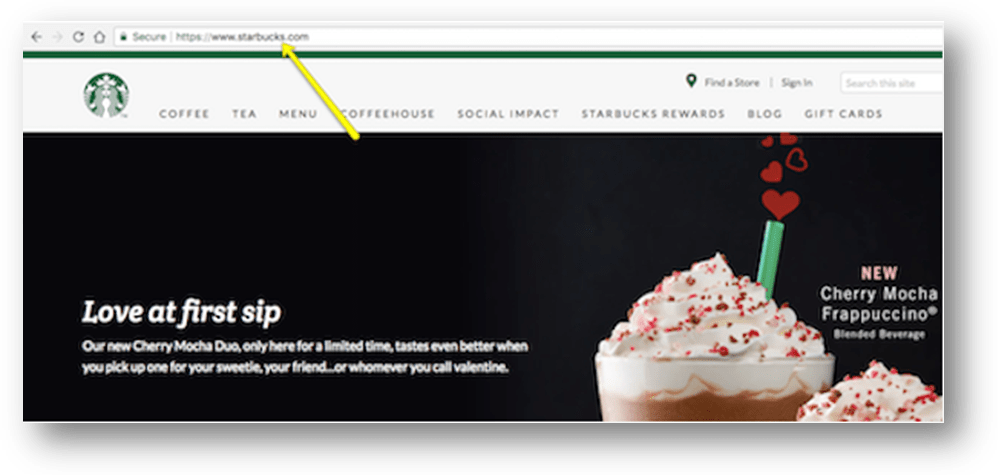
Choosing a domain name is a thoughtful task. Below are some of the things you must consider while creating/ choosing a domain name:
- Keep it simple and short: Create a domain name that is simple, short and easy to read, remember. It enhances the chance of users typing your website address correctly on the browser.
- Suitable for your website content: Make sure that your domain name is relevant to the content you are going to put on the website. Besides, you can also include keywords on the domain name if it sounds good.
- Choose an appropriate domain extension: Domain extension is the suffix such as .com, .net, .org, .edu, etc. which is added at the end of web addresses. They have specific meaning such as .com for commercial, .org for Organizations, and .net for network. These three extensions are the most used extensions which you can use as per the nature of your site; however, .com is always preferred.
Besides, there are some domain name generator tools which help to create a cool brand-able domain name.
- How to get a domain name?
There are several domain name providers online from where you can buy a domain name. Most of the domain name providers have a domain name search tool where you can type the name you want and it checks the availability of the domain name.
Below are the top domain Registrars you can check out:
- GoDaddy
- NameCheap
Step 2: Purchase Web Hosting and Domain
Web hosting does exactly what it says: it “hosts” websites. In other words, web hosting companies own and manage giant web servers located in data centers around the country (and, sometimes, the world).
It’s on these web servers where websites like yours sit, so you don’t have to buy or manage any of the server technology yourself. You pay these companies what amounts to monthly or annual rent for space and bandwidth on the server. Then, you can focus on building your website in WordPress.
Next, you have to find out the best WordPress hosting service which suits your needs. There are several web hosting companies offering different types of WordPress hosting plans. Below are the types of WordPress hosting plans you should know about:
- Shared Hosting: Cheapest hosting plan. With shared hosting, multiple websites share the same IP address and resources of the server including the memory, hard disk space, and the bandwidth. (Pros: Budget-friendly plan. Cons: Limited space, compromised speed and security)
- VPS (Virtual Private Server): With VPS plan, you will be provided a certain portion of server resources. You will share a server with other VPS users but there’ll limited users, not as many as in shared plan. (Pros: Secure, Option to get more server resources anytime as your business grows. Cons: Expensive for the small businesses and beginners.)
- Dedicated Hosting: Very expensive plan. All the server resources are dedicated to a single user. (Pros: Full storage, bandwidth, and full control over the server resources, more secure. Cons: Not a cost-effective plan for small companies.)
- Managed WordPress Hosting: Managed WordPress hosting is hosting cum WordPress management solution which provides some of the essential WordPress tools. It is a kind of dedicated hosting specific to WordPress platform. (Pros: WordPress-centered hosting. Cons: Quite expensive for small and growing businesses.
While there isn’t one clear front-runner when it comes to hosting providers, WordPress does give some solid recommendations on companies that not only work well with WordPress websites but that offer affordable hosting plans. I’d suggest you start with one of these if this is your first website.
Step 3: Install WordPress
There are a number of ways in which you can install WordPress. However, most web hosting providers will provide you with an easy-to-use one-click installation process that simplifies the whole process.
Using Bluehost as an example, here is what you need to do:
First, log into your new web hosting account:
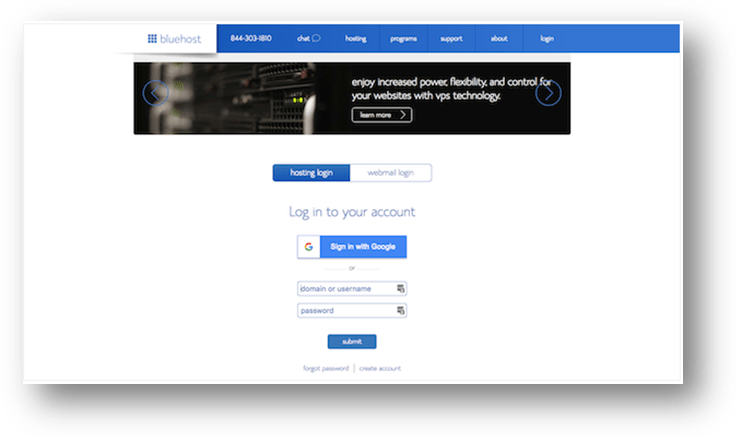
You’ll then arrive at your web hosting dashboard:
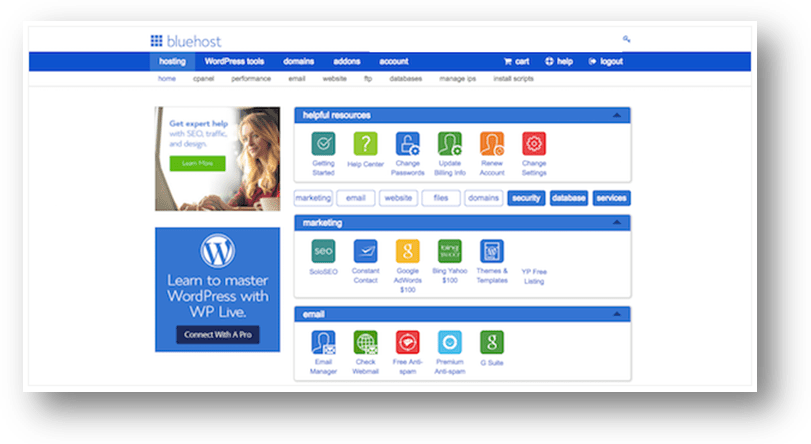
What you’ll want to look for instead is a button that says “Install WordPress”:
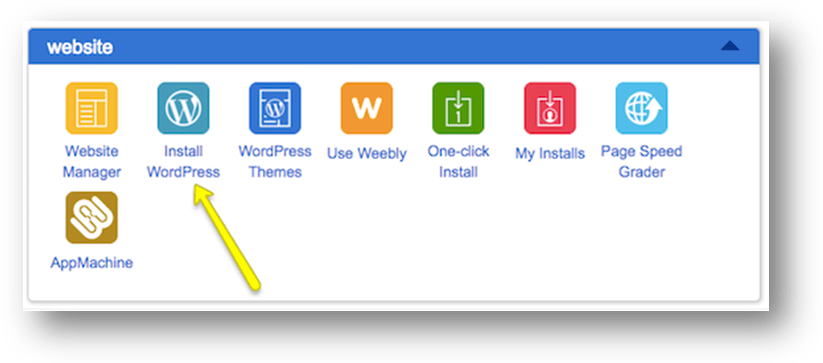
They may try to offer upgraded installation services, but there’s no need for that. Simply follow the instructions for installing WordPress. Once you have completed the installation and created your WordPress login credentials, it’s time to step inside. Unless you change your login domain (which you eventually should for security reasons), your admin login will be located at ‘www.yourdomainname.com/wp-login.php’.
Step 4: Find a WordPress Theme
A WordPress theme is a pre-designed and pre-coded interface template for WordPress. Basically, it saves you the trouble (and money) of having to design your own website from-scratch or to pay someone else to do it for you.
When you log into WordPress for the first time, WordPress will automatically assign their latest theme to your site.
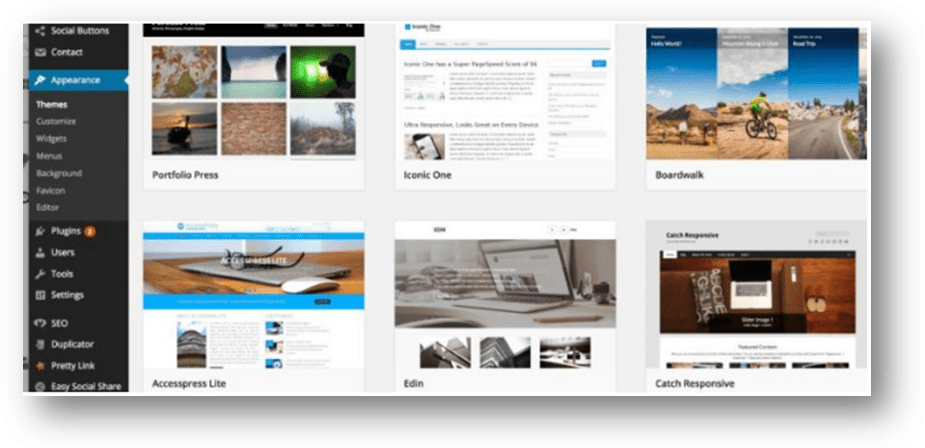
If you want to use a WordPress theme that works better for your niche, don’t be afraid to look around and to find the best and most trustworthy WordPress theme for your purposes.
Keep in mind that every theme requires some configuration. Also, not every theme works the same way. Some utilize a basic text editor (which looks similar to the blank page in Microsoft Word) while others use a page builder or visual editor. So, switching from one theme to another will force you to do a little rework if or when you make a switch. If you want to spare yourself the possible hassle, then don’t move on to the next steps until you’ve found the perfect WordPress theme for your site.
Step 5: Install Your WordPress Theme
When you find that perfect WordPress theme, it’s time install it in WordPress.
- Free WordPress Themes
If you’re using a free theme from the WordPress repository, here is what you need to do:
- Inside WordPress, go to the Appearance tab and click on “Themes”.
- At the top of the page, click on “Add New”. This will take you to the WordPress repository from within WordPress. Use this option so you don’t have to do any manual installation.
- Once you’re in the repository, do a search for the WordPress theme you want to use. Hover over it, and click the “Install” button.
- When it’s done installing, you then have to activate it in order to publish it to your WordPress site.
- Click on “Activate” (in the same spot where the “Install” button was) and wait for it to take you back into the main WordPress dashboard.
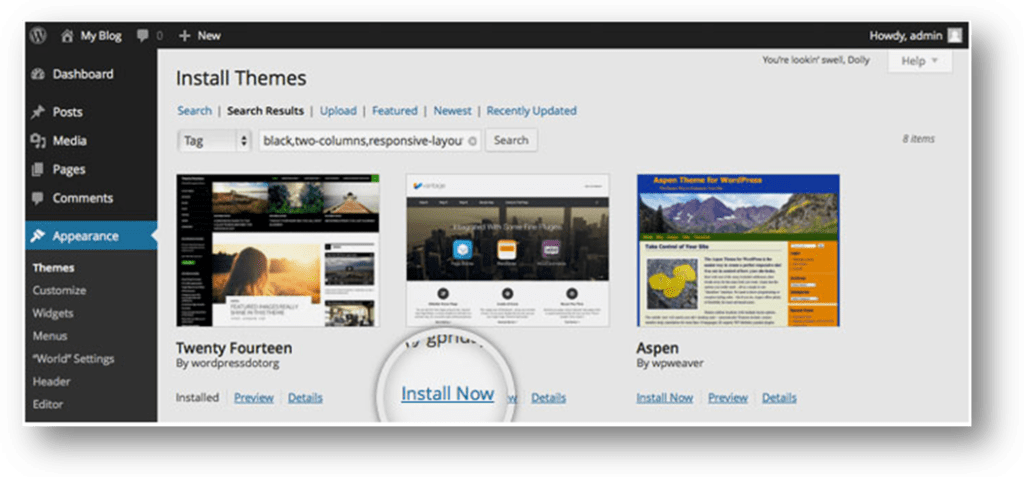
- Premium WordPress Themes
If you’ve decided to purchase a premium WordPress theme, the process will differ as third-party theme developers and marketplaces don’t sync directly to WordPress. Here is what you need to do:
- Go to your WordPress theme’s page and purchase the file. Once you’ve done this, you’ll be taken to a screen where you can download the theme file.
- If there is an option for it, download the “Installable WordPress Files Only”. This will give you a zipped folder you can then upload directly into WordPress.
- To do this, go back into WordPress, find the Appearance tab, and go to “Themes”. Click on “Add New” at the top. Only, this time, you’ll select the “Upload Theme” option.
- Select the zip file from your computer and click Install Now. With your new theme uploaded into WordPress, you can now activate and publish it to the site.
Step 6: Configure Your WordPress Theme
Upon activation, you’ll want to spend some time configuring your theme. You can do this under the Appearance tab and then click “Customize”.
Ultimately, it’s up to you to decide how much or little of your theme you want to customize. However, you should at least take some time now to go through each of the modules and acquaint yourself with what you have the power to change.
- Site Identity is an important one to fill in, so make sure you look at that first.
- Colors allow to update your site to your brand’s color palette (if you have one).
- Widgets allow you to add content to your footer.
Step 7: Publish Your First Pages
There are two types of “pages” you can create for your website:
- Page
These are traditional web pages that exist within the main navigation of a site. The About page, Contact page, and individual services pages all are made using the Page feature in WordPress.
- Post
These are blog post “pages” that will only exist within the blog on your website unless you designate the home page to serve as the blog feed.
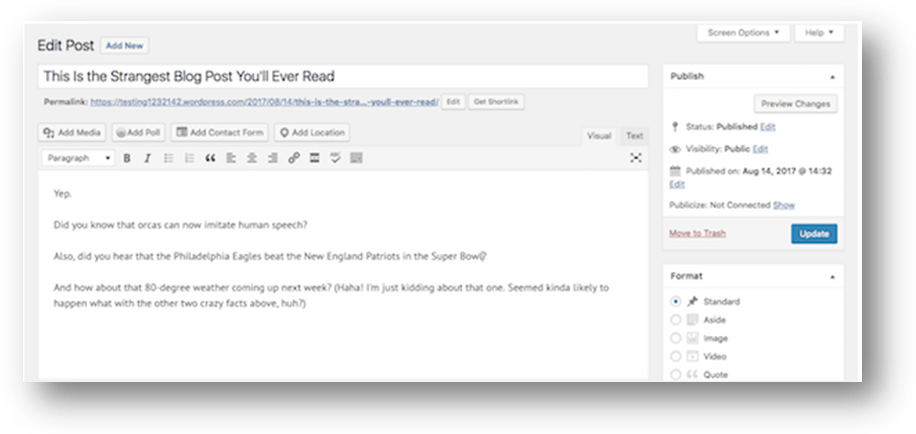
Now, the great thing about WordPress is that the interface is consistent regardless of whether you’re creating a page or a post. There are different settings you need to apply to each, but the main area in which you work remains the same, which makes it a workspace that’s easy to get used to.
Of course, if you work in a theme that uses a page builder or a visual builder tool to create content, this is going to look a little different.
Regardless of which content creation tool your WordPress theme uses, it’s time to create content for your site. If you’re running a blog, simply get started writing your first Posts. Once you hit the Publish button, your blogs will go live on the designated Blog page.
Step 8: Create a Menu
Whereas when you hit the “Publish” button on a Post and it goes straight onto your blog, a Page needs to be added to your site’s navigation (or menu) if you want it to show up.
So, the first thing to do is to create those pages for your site. Next, you’ll want to go to the Appearance tab and select “Menus”. This is where you will build and manage your site’s navigation.
First, let’s look at the menu selection dropdown. However, if your theme automatically creates secondary or footer menus for you, be sure to select the one you actually want to create/edit here. Next, let’s look at the sidebar options.
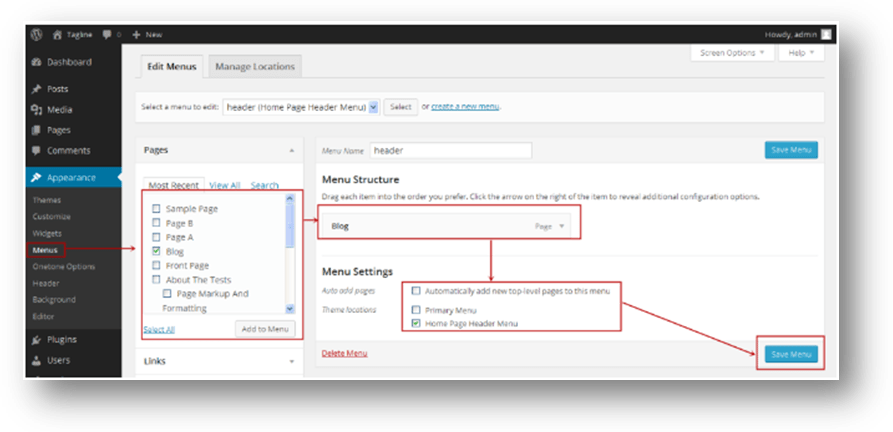
When you expand these tabs, you’ll be presented with pages, posts, and other types of content that already exist on your site. Now, it’s time to create your menu.
Click on the pages checkbox next to the page (or pages) you want to add to the sidebar. Then click on the “Add to Menu” button. You’ll see those pages then show up under Menu Structure.
Within this interface, you can now drag-and-drop your pages and design your menu to appear however you’d like it to. You can also change the page labels that appear in the navigation. One other thing to point out here is the Menu Settings box at the bottom.
If you know that you’ll be adding new pages regularly to your website and don’t want to have to repeat this process every time, you can click on the “Automatically add new top-level pages to this menu” option to streamline your process. When you’re done setting up your menu, save your changes.
Step 9: Configure Your WordPress Settings
Many of the settings offered by WordPress control things related to your pages and posts, and that’s not necessarily something you’d understand until you’ve actually created them for your site.
So, now that you’ve done that, it’s time to go through your settings one-by-one and make sure your WordPress site is configured to work exactly as you want it to.
- General
- Site Title: This is what will appear in someone’s browser tab when they arrive at your site.
- Tagline: This can be changed when you create content for your home page, so this isn’t a required field.
- WordPress Address: This is the URL of your main site.
- Site Address: For most of you, this will match the WordPress Address. However, if you are setting up something like Multisite that requires each site have its own sub-domain, you’ll specify that here.
- Email Address: This is for the main admin of your site, so they can receive all related notifications regarding it.
- Membership: If you want people to subscribe to your site for updates, click this box.
- New User Default Role: Keep this to Subscriber or Customer so that they can’t gain access to the backend of your site.
- Writing
- Default Post Category: If you’re including a blog on your site, you should eventually come in here and remove the “Uncategorized” category. You’ll want each new post to be assigned a category and removing the default setting will make it easier on yourself in the future.
- Default Post Format: For the most part, “Standard” should suffice unless you’re using your blog to share video, audio, or image galleries.
- Post via email: If you want to be able to write WordPress posts and email them to your site (which I wouldn’t advise), you can enable this setting here.
- Update Services: Leave this field be unless you have a private blog and don’t want people to know when you have new content available.
- Reading
- Your homepage displays: You have two choices when setting up a site in WordPress. You can let your homepage serve as the main blog roll so that visitors first encounter “Your latest posts”. Or you can create a full-blown website and let “A static page” you created serve as the home page.
- A static page: If you select this second option, you’ll need to designate a page to be your homepage and a page to automatically display your posts on.
- Blog pages show at most: If you show a summary of your blog posts (see option below), you can display up to 10 posts per page. If you show the full text, try to limit this to 3 posts.
- Syndication feeds show the most recent: When your blog shows up in someone’s RSS (syndication) feed, this setting enables you to choose how many recent posts they’ll see initially.
- For each article in a feed, show: This is up to you to decide, though I think a summary is probably best for improving the overall look on a main blog page’s feed. It also gives visitors a reason to click through and visit another page (which is good for SEO).
- Search engine visibility: Unless your website is private, do not check this box.
- Discussion
- Default article settings: The first setting refers to backlink notifications. The second setting refers to pingbacks and trackbacks. The third has to do with allowing comments on your blog.
- Other comment settings: If you do want visitors to leave comments, you can set requirements on who they are as well as how comments appear.
- Email me whenever: Staying engaged with people who take the time to comment on your content is a good thing. Check these so you can more easily stay on top of that.
- Before a comment appears: If you’re worried about spam or abusive comments coming through, update these settings.
- Comment Moderation/Blacklist: You can decide more specifically who is allowed to leave a comment (so long as it’s moderated) and who isn’t.
- Avatars: If you’re not running a membership site that allows users to create a full custom profile, be sure to update these settings to give your comments section a little personality.
- Media
If you’ve designed a custom WordPress site, you may have a need for custom media file sizes. In using this setting, you can streamline the media upload and sizing process. That way, visual content automatically goes into your pages at the right size and you don’t have to worry about making adjustments of it in your design software or compromising visibility of the image once it’s in WordPress.
Step 10: Install Essential WordPress Plugins
Installing WordPress plugins is the final step in the WordPress setup process.
In terms of what a WordPress plugin is, it’s a piece of software that hooks into WordPress. As for what it does? Well, plugins can do a lot of different things. They can help you:
- Integrate a social media feed into your site.
- Resize and compress images.
- Block spammers and hackers.
- Create a forum.
- Add a payment gateway.
- Translate your site.
- And much, much more.
While it’s tempting to look through the WordPress repository that currently houses over 50,000 free plugins and install all of the ones that seem really cool or worthwhile, be careful. WordPress plugins are like any other kind of file or software you layer on top of your site. With more weight, comes slower loading times–and that’s not something you want for your user experience.
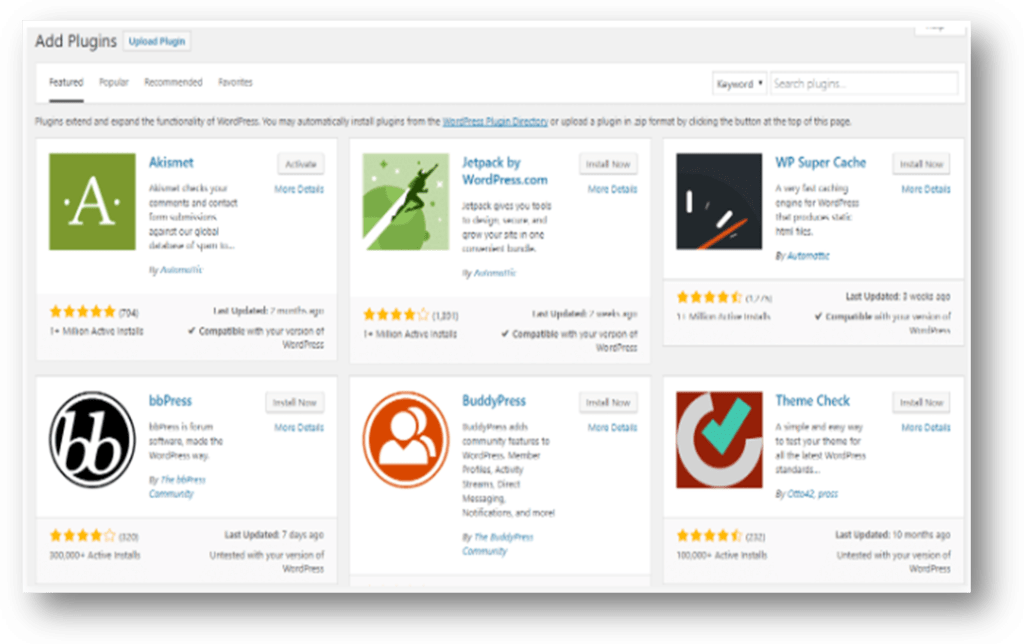
It’s also important to note that some of your plugins will generate their own new tab on the sidebar. Take WP Smush, for instance. If you’ve chosen to use this image optimization plugin, you’ll now find that it’s installed a new option on your sidebar. So, be sure to look out for those new tabs after activation as they hold valuable settings and features you’ll want to start accessing right away.
How to Maintain a WordPress Website?
If you want to host a successful WordPress site, you need to maintain its core functionality, installed plugins/themes, and other aspects on a regular basis. No doubt, WordPress is a great platform, but maintenance is a key that will keep you going longer across the global market.
However, maintaining a WordPress site is one of the tedious tasks, but it will help you know your efficiency, keep you updated with the latest technologies and most importantly, it remains safe and secure. So make sure you follow the right maintenance tactics that will boost the security, performance, and functionality of your site to a great extent. So, let’s take a look:
- Backup your site regularly: This is the most vital things that you need to do on a regular basis. Although backing up don’t keep your site fresh and clean, it helps if something goes wrong as you can revert to a previous version immediately. Backup your WordPress site on a monthly basis. You can also backup your blogs daily, while, weekly backups are good for corporate sites. You can back-up your site via your hosting provider or by downloading a local copy of your site through FTP.
- Keep your site up-to-date: If you want to maintain your site, you should update your core WordPress, installed themes and plugins to its latest version on a frequent basis. Fortunately, WordPress rolls out its latest version 4.6 frequently to offer their users more advanced features and security fixes.
All you need is to log in to your WordPress site on a monthly basis and update the core WP, themes, and plugins.
- Delete Unused plugins: WordPress plugins are a great way to extend the functionality of the site. But using too many plugins could affect the performance as well as the security of a website.
If you want a successful site, you need to remove all those plugins that you haven’t used till now. In short, get rid of the plugins that you don’t need. For that, you first need to deactivate the plugin, and then delete it. But before this, take a look at every plugin you have installed to find out the unused plugins.
- Optimize your database: A database is a place where all your site content is stored. It includes your blog posts, pages, images, videos, setting and much more. As your site grows, your database begins to get bloated, which in turn slow down the speed of your site.
If you want to improve the performance of your site, you need to optimize your database. With the help of WordPress plugin (such as WP-Optimize that will automatically optimize your database and clears records that are now not required), you can optimize the database of your site and enhance its speed.
- Focus on your site’s security: Most of the WordPress users overlook the security of their site. But it is one of the crucial factors that need to be considered. If you want to secure your site from hackers and other security threats, you need to install a reliable security plugin. You can use the iThemes Security plugin that will protect your site from hackers within a few clicks. In fact, you should also use a Sucuri service to monitor your site.
- Keep an eye on your site’s speed: If you want to attract more visitors, you need to provide them fast loading pages. This means the speed of a site directly affect the ranking of your site on search engines. In fact, Google prefers fast loading sites. So, you should know the loading speed of your site.
Luckily, there is Google’s PageSpeed Insights that offers a tool to grade your site’s load time, and then offers tips to improve it. You can install this tool and improve the performance of your site within a few clicks.
- Manage user accounts: The security of your site is also based on the aspect that how you manage your user accounts. Most of the website owners doll out their site’s password and leave it vulnerable. If you are a newbie user, you should avoid giving your login details to your multiple users. Each user should have their own login and password details as it gives more security to the site.
Apart from this, make sure you don’t use “admin” username for your WP account. Try to swap the default username with the new and unique one. You can also use the lengthy and difficult-to-break password. Plus, you can also change the URL of your login page if you want to protect your site from hackers and other security threats.
Conclusion:
WordPress is the undisputed champ of content management systems, which is why there’s never been a better time to learn how to use it. In just 10 steps (and some careful research and planning), you can get your first WordPress website up and running! Good luck!




